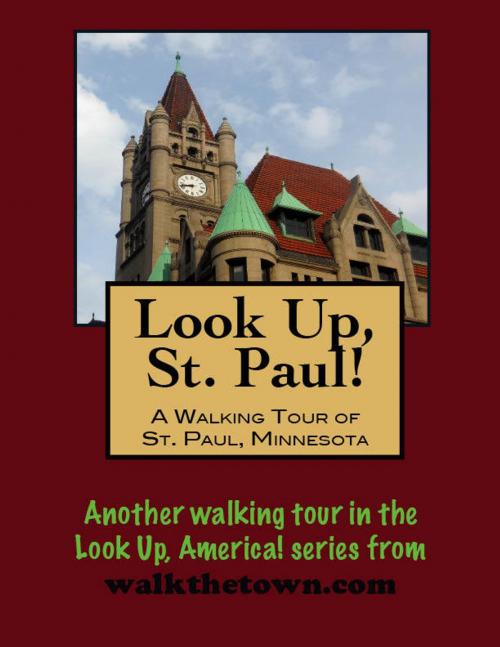Look Up, St. Paul! A Walking Tour of St. Paul, Minnesota
Nonfiction, Travel, United States, History, Americas| Author: | Doug Gelbert | ISBN: | 9781465925381 |
| Publisher: | Doug Gelbert | Publication: | September 6, 2011 |
| Imprint: | Smashwords Edition | Language: | English |
| Author: | Doug Gelbert |
| ISBN: | 9781465925381 |
| Publisher: | Doug Gelbert |
| Publication: | September 6, 2011 |
| Imprint: | Smashwords Edition |
| Language: | English |
There is no better way to see America than on foot. And there is no better way to appreciate what you are looking at than with a walking tour. Whether you are preparing for a road trip or just out to look at your own town in a new way, a downloadable walking tour is ready to explore when you are.
Each walking tour describes historical and architectural landmarks and provides pictures to help out when those pesky street addresses are missing. Every tour also includes a quick primer on identifying architectural styles seen on American streets.
Were it not for an offended Catholic priest Minnesota would today boast the most memorable of all state capital names...
The Dakota Indians considered the spot at the confluence of the Minnesota and Mississippi rivers the center of the world; European visitors recognized its strategic importance for trade and defense. On September 21, 1805 Zebulon Pike picked up 100,000 acres for $200 of trinkets, a keg of whiskey and the promise of a trading post. Colonel Josiah Snelling shaped the post into a military fort when he arrived in 1820 and Fort Snelling operated as through World War II and became the first National Historic Landmark in Minnesota in 1960.
No, the town that would become the capital was never named Snelling.
Just downstream from the fort a well-traveled and weary French Canadian fur trader named Pierre Parrant, then in his sixties and blind in one eye, staked a claim in 1832 to a patch of land at the entrance of a cave on the north bank of the Mississippi River. In addition to shelter the cave had the singular advantage of a spring which Parrant used to distill whiskey. "Pig's Eye" Parrant found ready customers in the soldiers from Fort Snelling and rivermen plying the Mississippi and the community that grew up around Pig's Eye's tavern took the same handle. Local residents had no qualms about living in Pigs Eye but when Catholic priest Lucien Galtier arrived he declared that in no way would his chapel bear the name of such a man of ill reputation. He named his chapel after his favorite saint and soon the settlement had jettisoned its first resident in favor of Paul the Apostle.
The Minnesota Territory was formalized in 1849 and St. Paul selected as its capital. As Minnesota prepared for statehood in 1858 a bill was passed to establish the capital in St. Peter on land owned by the Territorial Governor Willis A. Gorman. According to the story, legislator Joseph J. Rolette spirited the physical bill away and disappeared for a week, returning only after it was too late for the governor to sign the bill into law. Today, St. Paul is the second largest city in Minnesota with a population of a quarter of a million and St. Peter remains a small rural town with some 10,000 inhabitants.
While Minneapolis evolved as a place to make things, St. Paul's identity was forged in finance and business. Our walking tour of downtown St. Paul will find landmarks erected a century ago by the city's biggest players on the financial stage but we'll start with a few figures who never paid much mind to matters like that, characters from America's most popular comic strip...
There is no better way to see America than on foot. And there is no better way to appreciate what you are looking at than with a walking tour. Whether you are preparing for a road trip or just out to look at your own town in a new way, a downloadable walking tour is ready to explore when you are.
Each walking tour describes historical and architectural landmarks and provides pictures to help out when those pesky street addresses are missing. Every tour also includes a quick primer on identifying architectural styles seen on American streets.
Were it not for an offended Catholic priest Minnesota would today boast the most memorable of all state capital names...
The Dakota Indians considered the spot at the confluence of the Minnesota and Mississippi rivers the center of the world; European visitors recognized its strategic importance for trade and defense. On September 21, 1805 Zebulon Pike picked up 100,000 acres for $200 of trinkets, a keg of whiskey and the promise of a trading post. Colonel Josiah Snelling shaped the post into a military fort when he arrived in 1820 and Fort Snelling operated as through World War II and became the first National Historic Landmark in Minnesota in 1960.
No, the town that would become the capital was never named Snelling.
Just downstream from the fort a well-traveled and weary French Canadian fur trader named Pierre Parrant, then in his sixties and blind in one eye, staked a claim in 1832 to a patch of land at the entrance of a cave on the north bank of the Mississippi River. In addition to shelter the cave had the singular advantage of a spring which Parrant used to distill whiskey. "Pig's Eye" Parrant found ready customers in the soldiers from Fort Snelling and rivermen plying the Mississippi and the community that grew up around Pig's Eye's tavern took the same handle. Local residents had no qualms about living in Pigs Eye but when Catholic priest Lucien Galtier arrived he declared that in no way would his chapel bear the name of such a man of ill reputation. He named his chapel after his favorite saint and soon the settlement had jettisoned its first resident in favor of Paul the Apostle.
The Minnesota Territory was formalized in 1849 and St. Paul selected as its capital. As Minnesota prepared for statehood in 1858 a bill was passed to establish the capital in St. Peter on land owned by the Territorial Governor Willis A. Gorman. According to the story, legislator Joseph J. Rolette spirited the physical bill away and disappeared for a week, returning only after it was too late for the governor to sign the bill into law. Today, St. Paul is the second largest city in Minnesota with a population of a quarter of a million and St. Peter remains a small rural town with some 10,000 inhabitants.
While Minneapolis evolved as a place to make things, St. Paul's identity was forged in finance and business. Our walking tour of downtown St. Paul will find landmarks erected a century ago by the city's biggest players on the financial stage but we'll start with a few figures who never paid much mind to matters like that, characters from America's most popular comic strip...















